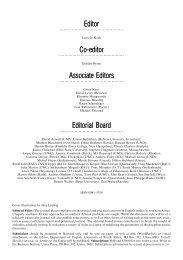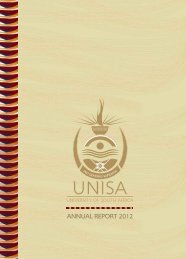Download the Annual report 2011 - Unisa
Download the Annual report 2011 - Unisa
Download the Annual report 2011 - Unisa
Create successful ePaper yourself
Turn your PDF publications into a flip-book with our unique Google optimized e-Paper software.
UNISA ANNUAL REPORT <strong>2011</strong><br />
Routine maintenance costs are recognised to profit or loss as <strong>the</strong>y are incurred. The costs of major maintenance<br />
or overhaul of an item of property, plant or equipment are recognised as an expense, except if <strong>the</strong> cost<br />
had been recognised as a separate part of <strong>the</strong> cost of <strong>the</strong> item of property, plant and equipment.<br />
2.5 INVESTMENT PROPERTIES<br />
Investment properties are properties which are ei<strong>the</strong>r held to earn rental income and/or for capital appreciation<br />
but not for sale in <strong>the</strong> ordinary course of business, for use in <strong>the</strong> production or supply of goods or services, or<br />
for administrative purposes. Owner-occupied properties are held for educational activities and administrative<br />
purposes. This distinguishes owner-occupied properties from investment properties.<br />
Investment properties are carried at cost less accumulated depreciation and accumulated impairment losses.<br />
Depreciation is calculated by using <strong>the</strong> straight-line method to write off <strong>the</strong> depreciable amount over <strong>the</strong> investment<br />
property’s estimated useful life.<br />
The useful life is currently:<br />
• Buildings and improvements - 50 years (2010 – 50 years)<br />
On disposal of an investment property, <strong>the</strong> difference between <strong>the</strong> net disposal proceeds and <strong>the</strong> carrying<br />
amount is recognised in profit or loss.<br />
2.6 NON-CURRENT ASSETS HELD FOR SALE<br />
Non-current assets (or disposal groups comprising assets and liabilities) which are expected to be recovered<br />
primarily through sale ra<strong>the</strong>r than through continuing use are classified as held for sale.<br />
Immediately before classification as held for sale, <strong>the</strong> assets (or components of a disposal group) are remeasured<br />
in accordance with <strong>the</strong> University’s accounting policies. Then, on initial classification as held for sale,<br />
non-current assets and disposal groups are recognised at <strong>the</strong> lower of <strong>the</strong> carrying amount and <strong>the</strong> fair value<br />
less costs to sell.<br />
Impairment losses on initial classification as held for sale are included in profit or loss. The same applies to<br />
gains and losses on subsequent re-measurement. Gains are not recognised in excess of any cumulative impairment<br />
loss. Any impairment loss on a disposal group is allocated to <strong>the</strong> assets and liabilities on a pro rata basis,<br />
except that no loss is allocated to inventories, financial assets and employee benefit assets, which continue to<br />
be measured in accordance with <strong>the</strong> University’s accounting policies.<br />
2.7 INTANGIBLE ASSETS<br />
An intangible asset is an identified, non-monetary asset that has no physical substance. An intangible asset is<br />
recognised when:<br />
• it is identifiable<br />
• <strong>the</strong> University has control over <strong>the</strong> asset as a result of a past event<br />
• it is probable that economic benefits will flow to <strong>the</strong> University<br />
• <strong>the</strong> cost of <strong>the</strong> asset can be measured reliably<br />
The amortisation period and amortisation method are reassessed annually.<br />
2.7.1 Research<br />
Expenditure on research activities undertaken with <strong>the</strong> prospect of gaining new scientific or technical knowledge<br />
and understanding is recognised in profit or loss when incurred.<br />
2.7.2 Computer software<br />
Acquired computer software that is significant and unique to <strong>the</strong> business is capitalised as an intangible asset<br />
on <strong>the</strong> basis of <strong>the</strong> cost incurred to acquire and make available for use <strong>the</strong> specific software.<br />
| 82 |

















